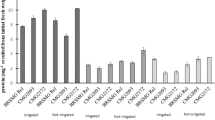Abstract
Cicer arietinum (gram) is an important protein-rich pulse crop in Indian subcontinent, the Mediterranean region, Ethiopia, and Mexico. We studied the effects of different salt concentrations on radicle growth and different markers of oxidative stress, e.g., superoxide radical, MDA, protein carbonyls, as well as antioxidant compounds. Physiological and biochemical parameters were assessed in the radicles of germinating gram seeds after 1 and 7 days of treatments with 15, 30, 45, and 60 mM NaCl. The results showed that salt exerted a stronger effect (17-fold) on radicle length than on their dry weight (5-fold). This growth decrease was accompanied by an excessive (3-fold) accumulation of ROS and resulting protein carbonyl and MDA formation (3–6-fold). As to the responses of antioxidant compounds to salinity of the growing medium, all the enzymatic molecules (SOD, CAT, POX, and APX) showed significant (4–6-fold) reductions in their activities. Our results suggest that under salinity substantially higher amounts of oxidative stress markers (superoxide, MDA, and protein carbonyls) in collaboration with suppression of the ROS detoxification system ultimately led to gram radicle growth inhibition and severe oxidative stress.
Similar content being viewed by others
Abbreviations
- APX:
-
ascorbate peroxidase
- CAT:
-
catalase
- DNP:
-
2,4-dinitrophenylhydrazine
- PMSF:
-
phenylmethylsulfonyl fluoride
- POX:
-
guaiacol peroxidase
- SOD:
-
superoxide dismutase
- TBARS:
-
thiobarbituric acid-reactive substances
References
Sahi, C., Singh, A., Kumar, K., Blumwald, E., and Grover, A., Salt Stress Response in Rice; Genetics, Molecular Biology and Comparative Genomics, Funct. Integr. Gen., 2006, vol. 6, pp. 263–284.
Khan, M.N., Siddiqui, M.H., Mohammad, F., Naeem, M., and Khan, M.A., Calcium Chloride and Gibberellic Acid Protect Linseed (Linum usitatissimum) from NaCl Stress by Inducing Antioxidative Defence System and Osmoprotectant Accumulation, Acta Physiol. Plant., 2010, vol. 32, pp. 121–132.
Davenport, S.B., Gallego, S.M., Benavidel, M.P., and Tomaro, M.L., Behaviour of Antioxidant Defense System in the Adaptive Responses to Salt Stress in Helianthus annuus L. Cells, Plant Growth Regul., 2003, vol. 40, pp. 81–88.
Azevedo, Neto, A.D., Prisco, J.T., Enas-Filho, J., Braga de Abreu, C.E., and Gomes-Filho, E., Effect of Salt Stress on Antioxidative Enzymes and Lipid Peroxidation in Leaves and Roots of Salt Tolerant and Salt Sensitive Maize Genotypes, Environ. Exp. Bot., 2006, vol. 56, pp. 87–94.
Parvaiz, A. and Satyawati, S., Salt Stress and Phyto Biochemical Responses of Plants, Plant Soil Environ., 2008, vol. 54, pp. 89–99.
D’souza, M. and Devaraj, V.R., Biochemical Responses of Lablab purpureus to Salinity Stress, Acta Physiol. Plant., 2010, vol. 32, pp. 341–353.
Oueslati, S., Karray-Bouraoui, N., Attia, H., Rabhi, M., Ksouri, R., and Lachaal, M., Physiological and Antioxidant Responses of Mentha pulegium to Salt Stress, Acta Physiol. Plant., 2010, vol. 32, pp. 289–296.
Candan, N. and Tarhan, L., The Correlation between Antioxidant Enzyme Activities and Lipid Peroxidation Levels in Mentha pulegium Organs Grown in Ca2+, Mg2+, Cu2+, Zn2+, and Mn2+ Stress Conditions, Plant Sci., 2003, vol. 163, pp. 769–779.
Yasar, F., Ellialtioglu, S., and Yildiz, K., Effect of Salt Stress on Antioxidant Defense Systems, Lipid Peroxidation, and Chlorophyll Content in Green Bean, Russ. J. Plant Physiol., 2008, vol. 55, pp. 782–786.
Bowler, C., van Montagu, M., and Inze, I., Superoxide Dismutase and Stress Tolerance, Annu. Rev. Plant Physiol. Plant Mol. Biol., 1992, vol. 43, pp. 83–116.
Lauter, D.J. and Munns, D.N., Salt Resistance of Chickpea Genotypes in Solutions Salinized with NaCl or Na2SO4, Plant Soil, 1986, vol. 95, pp. 271–279.
Sangeetha, P., Das, V.N., Koratkar, R., and Suryaprabha, P., Increase in Free Radical Generation and Lipid Peroxidation Following Chemotherapy in Patients with Cancer, Free Radic. Biol. Med., 1990, vol. 8, pp. 15–19.
Heath, R.L. and Packer, L., Photoperoxidation of Isolated Chloroplasts; Kinetics and Stoichiometry of Fatty Acid Peroxidation, Arch. Biochem. Biophys., 1968, vol. 125, pp. 189–198.
Bradford, M.M., A Rapid and Sensitive Method for Quantification of Microgram Quantities of Protein Utilizing Principle of Protein-Dye Binding, Anal. Biochem., 1976, vol. 72, pp. 248–254.
Levine, R.L., Williams, J.A., Stadtman, E.R., and Schater, E., Carbonyl Assay for Determination of Oxidatively Modified Proteins, Methods Enzymol., 1994, vol. 233, pp. 346–363.
Marklund, S. and Marklund, G., Involvement of the Superoxide Anion Radical in the Auto-Oxidation of Pyrogallol and a Convenient Assay for Superoxide Dismutase, Eur. J. Biochem., 1974, vol. 47, pp. 469–474.
Chance, B. and Maehly, A.C., Assays of Catalase and Peroxidase, Methods in Enzymology, vol. 2, Colowick, S.P. and Kaplan, N.O., Eds., New York: Academic, 1955, pp. 443–450.
Nakano, Y. and Asada, K., Hydrogen Peroxide Is Scavenged by Ascorbate Specific Peroxidase in Spinach Chloroplast, Plant Cell Physiol., 1981, vol. 22, pp. 867–880.
Pacifici, R.E. and Davies, K.J.A., Protein Degradation as an Index of Oxidative Stress, Methods Enzymol., 1990, vol. 186, pp. 485–502.
Kumar, V., Shriram, V., Nikam, T.D., Jawali, N., and Shitole, M.G., Antioxidant Enzyme Activities and Protein Profiling under Salt Stress in indica Rice Genotypes Differing in Salt Tolerance, Arch. Agron. Soil Sci., 2009, vol. 55, pp. 379–394.
Hodges, M., Oxidative Stress in Post Harvest Produce, Post Harvest Oxidative Stress in Horticulture Crops, Hodges, M., Ed., New York: Food Products Press, 2003, pp. 1–12.
Polle, A., Defense against Photooxidative Damage in Plants, Oxidative Stress and the Molecular Biology of Antioxidant Defenses, Scandalios, J., Ed., New York: Cold Springer Harbor Lab., 1997, pp. 785–813.
Author information
Authors and Affiliations
Corresponding author
Additional information
Published in Fiziologiya Rastenii, 2012, Vol. 59, No. 2, pp. 232–237.
This text was submitted by the authors in English.
Rights and permissions
About this article
Cite this article
Keshavkant, S., Padhan, J., Parkhey, S. et al. Physiological and antioxidant responses of germinating Cicer arietinum seeds to salt stress. Russ J Plant Physiol 59, 206–211 (2012). https://doi.org/10.1134/S1021443712010116
Received:
Published:
Issue Date:
DOI: https://doi.org/10.1134/S1021443712010116




